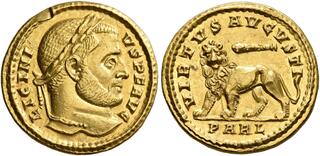| Leu Numismatik AG > Auction 15 | Auction date: 1 June 2024 |
| Lot number: 304 Price realized: This lot is for sale in an upcoming auction - Bid on this lot  | Show similar lots on CoinArchives Find similar lots in upcoming auctions on |
| Lot description: Licinius I, 308-324. Solidus (Gold, 18 mm, 4.49 g, 6 h), Arelate, spring 313. LICINI-VS P F AVG Laureate head of Licinius I to right. Rev. VIRTVS AVGVSTI / PARL Lion advancing to left, head facing; above, club to left. Alföldi, Goldprägung, 673. Cohen 180. Depeyrot 1/6. Depeyrot, Émissions, 2/4. RIC 5 = Trau 3796 (same dies). Of the highest rarity, apparently the third known example. A magnificent piece with a wonderful rendering of a lion on the reverse. A few light marks and with some scrapes on the edge of the obverse and on the reverse, otherwise, nearly extremely fine. This wonderful Solidus was issued by Constantine I in Arelate, in modern-day Arles in Provence, on his way back from Mediolanum (Milan) to Treveri (Trier). In February-March 313, Constantine met Licinius I in Mediolanum and together they issued the Edict of Milan, which guaranteed free religious practice to all inhabitants of the empire, especially Christians. Additionally, Licinius married Constantine's half-sister Flavia Julia Constantia (see lot 303 above). While Licinius moved east to fight Maximinus II in the spring of 313, Constantine returned to his main residence in Treveri. As shown by the present gold coin from Arelate, he also made a stop in Provence. Constantine's first gold emission from Arelate - one of only two from his entire reign - consists of only two types, both of which are iconographically very unusual and were issued for both him and his co-emperor Licinius. The first, inscribed with PRINCIPIS PROVIDENTISSIMI SAPIENTIA, praises the 'wisdom' of the 'far-sighted Princeps', which has been seen as a reference to the Edict of Milan (see the commentary in Leu 8 (2021), 380), while the second depicts a lion walking to the left. The emission in the name of Licinius, now known in three surviving examples, comes from a single pair of dies, which shows a club above the lion on the reverse, clearly identifying it as a Herculean motive. This design likely draws upon Herculean traditions originating from Ostia, a mint renowned for perpetuating the Herculean legacy of Maximianus Herculius during Maxentius's reign, before its transfer to Arelate subsequent to Constantine's triumph. Particularly striking iconographically is the design of the lion's head, which is not shown in profile as is usual, but instead directly faces the viewer. This creates an intense interaction between motif and viewer, who can hardly escape the gaze of the king of beasts. Estimate: 20000 CHF |  |



